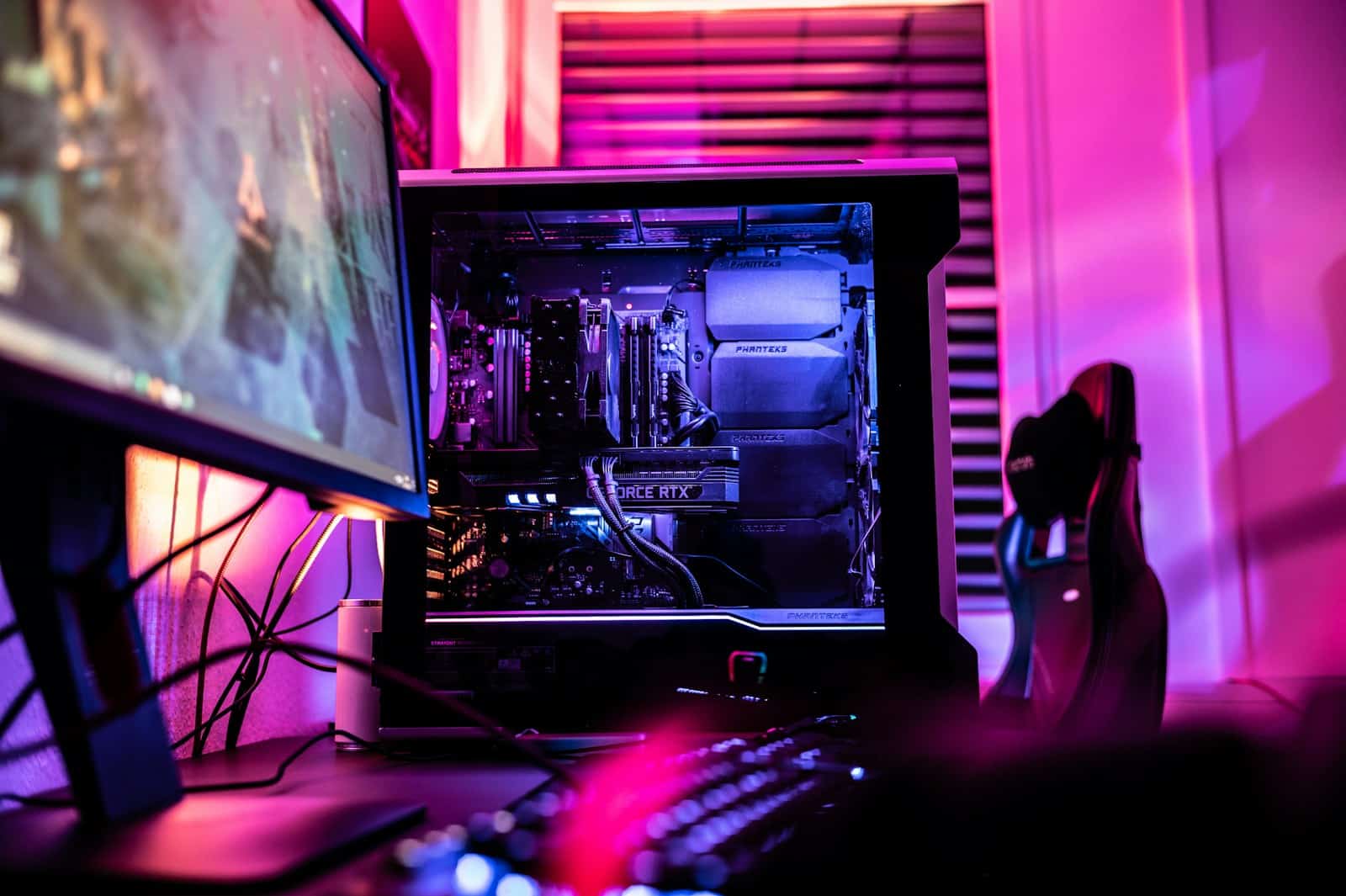Finding a good entry-level gaming PC can be tough. There are many brands and options to choose from, and prices vary a lot. The best entry-level gaming PCs offer good value without breaking the bank. Options like the HP Victus 15L and Legion Tower 5i stand out for their mix of price and performance.
Many first-time PC gamers want something that works well but doesn’t cost too much. A good starter gaming PC should run most games at decent settings while staying under budget. The good news is that several companies now make gaming PCs that are both affordable and powerful enough for new gamers.
Gaming PCs don’t need to break the bank. In 2026, you can get a solid entry-level machine for $600–$1,000 that handles 1080p gaming smoothly and even dips into 1440p for less demanding titles.
🔑 What to Expect from an Entry-Level Gaming PC in 2026
- Resolution: 1080p high settings in most games; 1440p medium in esports or lighter AAA titles.
- Frame Rates: 60–120 FPS in esports (Valorant, CS2, Fortnite), 40–60 FPS in demanding AAA games.
- Hardware: Latest-gen CPUs (Intel 14th/15th Gen or AMD Ryzen 7000/8000 series), budget GPUs (RTX 4060, RX 7600 XT, Intel Arc A770).
- Price Range: $600–$1,000 prebuilt or custom build.
🖥️ Best Prebuilt Entry-Level Gaming PCs (2026)
1. HP Omen 25L (2026 Refresh)
- CPU: AMD Ryzen 5 7600
- GPU: NVIDIA RTX 4060
- RAM: 16GB DDR5
- Storage: 512GB NVMe SSD
- Why it’s great: Reliable, upgrade-friendly, and excellent cooling for a prebuilt.
- Best for: Beginners who want a plug-and-play gaming PC.
2. Lenovo Legion Tower T5 (2026 Edition)
- CPU: Intel Core i5-14400F
- GPU: AMD Radeon RX 7600 XT
- RAM: 16GB DDR5
- Storage: 1TB SSD
- Why it’s great: Balanced build with strong CPU + GPU combo, good for 1080p/1440p.
- Best for: Gamers who want value without sacrificing performance.
3. NZXT Player: One (2026 Model)
- CPU: Intel Core i5-14500
- GPU: NVIDIA RTX 4060 Ti
- RAM: 16GB DDR5
- Storage: 1TB NVMe SSD
- Why it’s great: Sleek design, solid airflow, and NZXT’s reputation for quality.
- Best for: Style-conscious gamers who also want performance.
4. Skytech Chronos Mini (2026 Edition)
- CPU: AMD Ryzen 5 7600X
- GPU: NVIDIA RTX 4060
- RAM: 16GB DDR5
- Storage: 500GB SSD
- Why it’s great: Compact, affordable, and esports-ready.
- Best for: Small desk setups and budget-conscious gamers.
🛠️ Best DIY Entry-Level Build (Around $900 in 2026)
If you’d rather build your own, here’s a balanced parts list:
- CPU: Intel Core i5-14400F (~$220)
- GPU: AMD Radeon RX 7600 XT (~$300)
- Motherboard: B760 ATX DDR5 (~$130)
- RAM: 16GB DDR5-5600 (~$70)
- Storage: 1TB NVMe SSD (~$60)
- PSU: 650W 80+ Bronze (~$60)
- Case: Mid-tower with airflow (~$70)
➡️ This build will outperform most prebuilts at the same price and leave room for future upgrades.
📊 Quick Comparison Table (2026 Entry-Level PCs)
| Model | CPU | GPU | RAM | Storage | Price (est.) |
|---|---|---|---|---|---|
| HP Omen 25L | Ryzen 5 7600 | RTX 4060 | 16GB | 512GB | $899 |
| Lenovo Legion T5 | i5-14400F | RX 7600 XT | 16GB | 1TB | $949 |
| NZXT Player: One | i5-14500 | RTX 4060 Ti | 16GB | 1TB | $999 |
| Skytech Chronos Mini | Ryzen 5 7600X | RTX 4060 | 16GB | 500GB | $799 |
| DIY Custom Build | i5-14400F | RX 7600 XT | 16GB | 1TB | ~$900 |
🏆 Final Recommendation
- Best Overall Value: Lenovo Legion T5 (2026 Edition) – balanced, affordable, and upgradable.
- Best for Esports Gamers: Skytech Chronos Mini – compact and budget-friendly.
- Best Long-Term Investment: DIY Custom Build – more performance per dollar and upgrade flexibility.
- Best Plug-and-Play Premium Option: NZXT Player: One – stylish, strong, and ready to go.
✅ Bottom line: In 2026, an entry-level gaming PC under $1,000 can deliver smooth 1080p gaming and even push into 1440p. Go prebuilt if you want convenience, or build your own for maximum value.
1. HP Victus 15L
The HP Victus 15L stands out as a solid entry-level gaming PC for newcomers to the gaming world. It comes in a compact design that won’t take up much space on your desk or floor.
This desktop offers good value with configurations featuring either Intel Core i7 or AMD Ryzen processors. Both options provide enough power for modern games at reasonable settings.
The Victus 15L includes up to 2TB of storage, giving you plenty of room for your game library. This eliminates the frustration of constantly uninstalling games to make space for new ones.
One standout feature is the 9 USB ports, which allow you to connect all your gaming peripherals without needing additional hubs. This makes setting up your gaming station much easier.
Budget-conscious gamers will appreciate the affordable configurations, with some models starting at just $499. These typically include an AMD Ryzen 5 5600G processor and RX 6400 graphics card.
The base models usually come with 8GB of RAM and 512GB SSD storage. While this works for casual gaming, you might want to upgrade the RAM for better performance with newer titles.
HP designed the Victus 15L to be ready for Windows 11. This ensures compatibility with the latest operating system features and updates. This helps future-proof your investment.
The desktop comes in a sleek Mica Silver finish, giving it a clean, professional look that fits in both gaming setups and more formal spaces. The case design is modern without being flashy.
According to user reviews, the Victus 15L offers excellent performance not just for gaming but also for graphic design and video editing tasks. This makes it a versatile option for creative work.
For beginners, the Victus 15L provides an easy entry point to PC gaming without requiring technical knowledge about building computers. It works right out of the box with minimal setup.
The compact footprint makes this desktop a good choice for smaller spaces. You won’t need to rearrange your entire room to accommodate this gaming PC.
2. Lenovo Legion Tower 5i
The Lenovo Legion Tower 5i stands out as one of the best budget gaming PCs from a known brand. It offers solid performance for gamers who want a pre-built system without the hassle of assembling components themselves.
This gaming desktop comes with powerful hardware options including Intel Core processors and NVIDIA GeForce RTX graphics cards. The newest models feature 14th Gen Intel Core desktop processors paired with RTX 40 series graphics, making it ready for modern games.
The tower boasts a redesigned chassis with improved airflow. Its mesh venting and up to 150W air cooling keep components running at optimal temperatures even during intense gaming sessions.
Users praise the Legion Tower 5i for its ease of access. The case is easy to open and work on, making future upgrades simple for those who want to extend the life of their system.
For 1080p gaming, this desktop delivers excellent performance. Many gamers find it hits the sweet spot between price and capabilities, providing smooth gameplay without breaking the bank.
Reddit users have noted that the Legion Tower 5i is very good for those who don’t want to deal with building a PC themselves. Some users recommend the AMD variants for potentially better value.
Memory and storage options are generous for the price point. Most configurations come with 16GB of RAM and 1TB SSD, giving players enough space for several big games and fast load times.
The Legion Tower 5i has been called the platonic form of an entry-level gaming PC. It doesn’t try to be flashy or over-complicated, instead focusing on delivering reliable gaming performance at a reasonable price.
Expandability is another strong point for this desktop. The highly expandable chassis allows gamers to upgrade components as their needs change or as they save up for better parts.
The clean design fits well in most settings. While it has gaming aesthetics, the Tower 5i isn’t covered in excessive RGB lighting, making it suitable for both gaming setups and more professional environments.
3. Allied Stinger Desktop
The Allied Stinger Desktop is a solid choice for gamers looking to start their gaming journey. This entry-level gaming PC comes at an affordable price point, starting from just $769.
The Allied Stinger features a compact mid-tower design that uses an M-ATX case. This smaller form factor helps it fit easily on or under most desks without taking up too much space.
For processing power, the Allied Stinger offers options up to Ryzen 5 and Core i5 processors. These mid-range CPUs provide enough power for most modern games at decent settings.
Graphics options include NVIDIA GTX/RTX 3000 Series and AMD RX 6000 Series cards. In some builds, you might get an RTX 3060 8GB, which handles 1080p gaming with ease.
Memory configurations typically include 16GB of DDR4 RAM. This amount is the sweet spot for gaming in 2025, offering enough headroom for games and background applications.
Storage comes in the form of 1TB NVMe SSDs in most builds. The fast NVMe technology ensures quick load times for operating systems and games.
Allied offers the Stinger in different tiers. The Starter tier begins at $769, while the Mid tier costs around $1,049. For those wanting more power, the Mid-High tier starts at $1,259.
Some users have reported getting better motherboards than advertised. One buyer mentioned receiving a B350M motherboard instead of the listed A320M, which was a welcome upgrade.
The latest models of the Stinger can support higher-end components. Newer versions can accommodate up to Ryzen 9 and Core i7 processors along with NVIDIA RTX 40 Series and AMD RX 7000 Series graphics.
For new gamers, the entry-level Stinger with a Ryzen 3 4100 processor and GTX 1050 Ti offers a good starting point. This combo handles esports titles and many popular games at lower settings.
The power supply in base models typically comes in at 550W. This provides enough power for the included components while allowing for some future upgrades.
4. Maingear Zero Ruby
The Maingear Zero Ruby stands out as a top choice for gamers looking to enter the PC gaming world. This pre-built system offers an impressive balance of power and price that makes it perfect for beginners.
According to recent reviews, the Zero Ruby handles both 1440p and 4K gaming with ease. The system comes with up-to-date mid-range components that work together smoothly right out of the box.
One of the standout features is the AMD 7800X3D processor. This CPU was built specifically for gaming and provides excellent performance for the price point. When paired with the included NVIDIA RTX 4070 Super graphics card, gamers get a powerful combo for most modern titles.
Maingear takes pride in their quality control process. Each PC goes through rigorous stress testing before shipping, ensuring customers receive a reliable system from day one.
First-time buyers often praise the Zero Ruby for its value. The pre-qualified hardware selection means new PC owners don’t need to worry about compatibility issues or complex setup processes.
The clean design of the Zero Ruby fits well in most gaming setups. Its case provides good airflow for the components, helping maintain lower temperatures during long gaming sessions.
Customer service is another area where Maingear shines. As a boutique PC builder with over 20 years of experience, they offer support that often exceeds what you’d get from larger manufacturers.
The Zero Ruby has earned its place as one of the best gaming PCs on the market. It combines powerful specs with reasonable pricing and excellent customer experience.
For gamers who want to skip the hassle of building their own PC, the Zero Ruby offers a straightforward path to high-quality gaming. The system works well right after unboxing, with minimal setup required.
5. Alienware Aurora R16
The Alienware Aurora R16 Gaming Desktop is a good choice for new gamers. This Dell-made system offers performance and a more down-to-earth design compared to earlier models.
The R16 features modern components that can handle today’s games well. Most configurations come with either 12th or 13th Gen Intel Core processors paired with NVIDIA GeForce RTX 40 series or AMD Radeon RX graphics cards.
For beginners, the system offers good value in its base configurations. The standard model includes 16GB of DDR5 RAM and storage options that typically combine SSD speed with HDD capacity.
One standout feature is the R16’s more compact design. Unlike some flashier gaming PCs, this model has a cleaner look that fits better in different living spaces.
Recent builds include options with an Intel Core i7-14700F processor, which provides strong gaming performance. This pairs well with graphics options like the RTX 4060, which handles 1080p gaming smoothly.
The R16 also improves on cooling compared to previous Alienware models. Better airflow means components stay cooler during long gaming sessions, which helps both performance and system longevity.
New gamers will appreciate the ready-to-play nature of this system. It comes with Windows 11, and Dell includes its command center software for easy performance monitoring and customization.
Reviews note that the R16 is surprisingly down-to-earth for a Dell gaming PC. While it may not have the flashy appearance of other gaming rigs, it makes up for this with reliable performance.
Storage options typically include a 512GB SSD for quick loading times, often paired with a larger HDD for game libraries. This combination works well for most new gamers who don’t want to constantly manage space.
When considering value, some gamers suggest looking at other options. Discussion forums mention that there might be better value prebuilt options available from other manufacturers.
The build quality meets Dell’s usual standards with clean cable management and easy access for future upgrades. This makes it a good choice for new gamers who might want to improve components later.
6. HP Omen 25L
The HP Omen 25L is a good choice for new gamers looking to enter the PC gaming world. This desktop offers a good mix of power and affordability that makes it perfect for those just starting their gaming journey.
The Omen 25L comes in a striking, tall case with RGB lighting that adds a gaming aesthetic without going overboard. Its clean design fits well in most home setups while still looking like a gaming machine.
HP built this desktop to handle 1080p gaming with ease. It delivers rock-solid performance for most popular games at this resolution, which is exactly what most entry-level gamers need.
One big advantage of the Omen 25L is its customization options. Buyers can pick from different processors, graphics cards, and memory configurations to match their budget and gaming needs.
For those just getting started, the entry-level models provide good value and enough power for casual gaming. Some models even support amateur photo and video editing work.
The system uses standard parts, making future upgrades easier. This means gamers can start with a basic model and improve it over time as their skills and needs grow.
Recent models come with AI-powered GPUs and refined build quality, showing HP’s commitment to keeping this line current with gaming technology.
Some versions feature the Intel Core i5-14400F processor, which offers good gaming performance without breaking the bank. Higher-end models may include stronger CPUs and better graphics cards.
The cooling system in the Omen 25L handles standard gaming loads well. Players should check that cooling is sufficient if they plan to upgrade to more powerful components later.
HP designed the Omen 25L to be a great choice for gamers of all levels. It hits the sweet spot of being powerful enough for today’s games while remaining budget-friendly for newcomers.
Memory options typically start at 16GB and go up to 32GB of DDR5 in newer models, providing plenty of room for multitasking and memory-hungry games.
Storage usually includes a fast SSD for quick game loading and system responsiveness. Most configurations offer at least 512GB of space, with some providing 1TB or more.
7. MSI Codex R2
The MSI Codex R2 is a solid choice for gamers seeking their first gaming PC. This mid-tower system comes with a glass side panel and plenty of RGB lighting to show off your gaming setup.
Starting at around $979.99, the Codex R2 offers good value for budget-conscious gamers. It packs decent midrange hardware that handles 1080p gaming well without breaking the bank.
Many configurations are available, including models with Intel’s newest 14th Gen processors. The system typically pairs these CPUs with Nvidia 40-series graphics cards for smooth gaming performance.
Customers praise the Codex R2 for its great performance in modern games. It runs the latest games smoothly at 1080p resolution, making it perfect for new gamers.
The PC uses standardized MSI components, which means better stability during intense gaming sessions. This standardization also makes future upgrades easier.
Some models feature the Intel Core i5-14400F processor paired with an RTX graphics card. This combination delivers excellent gaming power at 1080p resolution.
Most Codex R2 configurations come with 16GB of RAM and an SSD for storage. The SSD helps games load quickly, while 16GB of RAM is enough for most current games.
One thing to note is that some users report the cooling fans can be noisy. According to user feedback, the Codex R2 may run louder than some competing systems like Lenovo Legion towers.
The PC is assembled in the USA with quality in mind. This attention to build quality helps ensure the system stays reliable even during long gaming sessions.
For those who want an entry-level gaming PC that can handle current games well, the MSI Codex R2 hits a sweet spot of price and performance. It offers the power needed for 1080p gaming without costing as much as high-end gaming rigs.
8. CLX Set
CLX Set is a solid option for gamers seeking an entry-level gaming PC. This line of budget-friendly computers starts at just $599, making it accessible for those new to PC gaming.
The CLX Set is designed as a mid-sized gaming desktop with smooth designs that won’t break the bank. These computers feature a good balance of performance and value that beginners will appreciate.
One of the benefits of CLX gaming systems is that they use name-brand, industry-tested components. This gives buyers more confidence in their purchase compared to some other budget options on the market.
CLX offers both pre-built systems and a custom PC builder tool. New gamers who feel overwhelmed by technical choices can simply buy a pre-configured system. Those who want more control can use their AI shopping assistant to create a custom build.
Users on Reddit have shared positive experiences with CLX. One customer mentioned that the company’s build interface was user-friendly, which is helpful for first-time buyers who might feel intimidated by the process.
While CLX offers high-end options, their entry-level PCs provide good value. They focus on delivering a complete gaming experience across different price points, so even their budget models will run most popular games.
For those concerned about future upgrades, the mid-tower design of CLX Set PCs offers plenty of room for adding components later. This makes them a smart long-term investment for new gamers.
CLX Set computers are available through the company’s website and major retailers like Best Buy. This wide availability makes it easy to find and purchase these systems.
The company also provides customer support for their products, which is especially valuable for new PC gamers who might need help setting up or troubleshooting their system.
9. Asus Rog Ally Z1
The Asus ROG Ally Z1 offers a fresh take on what an entry-level gaming PC can be. Instead of a traditional desktop tower, this handheld gaming device packs surprising power in a portable form factor.
The ROG Ally Z1 can handle many popular games at decent settings, thanks to its performance comparable to a GTX 1650 graphics card. It’s essentially an entry-grade gaming desktop in terms of GPU power, but in your hands.
The device features a vibrant Full HD screen with bright, accurate colors. Games look sharp and clear, making it easy to spot details even on the compact display.
Battery life is impressive for a portable gaming system. Tests show the ROG Ally can run for nearly 8 hours in certain conditions, giving players plenty of gaming time between charges.
For budget-conscious gamers, the ROG Ally Z1 presents an interesting alternative to traditional desktop PCs. It combines mobility with respectable performance at a price point that won’t break the bank.
The standard Z1 model is perfect for casual gamers who enjoy indie titles and less demanding games. Those wanting more power can consider the Z1 Extreme version, which offers enhanced performance for more graphically intense games.
Windows compatibility means the ROG Ally can run most PC games right out of the box. This gives players access to their existing Steam, Epic, or Game Pass libraries without extra steps.
Storage options allow for expansion through microSD cards or external drives. This flexibility helps gamers maintain a solid library of titles without constant uninstalling and reinstalling.
The built-in controls eliminate the need for separate keyboards, mice, or controllers. Everything needed to play is integrated into the compact design.
For those who want the best of both worlds, the ROG Ally can connect to external monitors, keyboards, and mice. This versatility transforms it from a handheld device into a more traditional desktop setup when desired.
10. Corsair Vengeance i7600
The Corsair Vengeance i7600 stands out as a premium gaming PC with exceptional build quality. It offers excellent gaming performance while maintaining quiet operation, making it a top choice for serious gamers.
This powerful system comes equipped with an Intel Core Ultra processor that delivers next-gen AI capabilities. The processor helps achieve ultra-smooth gameplay and better power efficiency when compared to previous generations.
Cooling is a priority in the i7600 design. The system features liquid cooling for the Intel Core Ultra processor, which helps maintain optimal temperatures during intense gaming sessions.
Graphics performance is handled by NVIDIA’s powerful RTX series GPUs. Depending on the configuration, buyers can choose between the RTX 4070 Ti Super or the more powerful RTX 4080 Super.
Memory is another strong point for the i7600. It comes with 32GB of DDR5 RAM, providing plenty of headroom for multitasking and memory-intensive games.
Storage needs are covered by a fast 1TB M.2 SSD. This ensures quick boot times and speedy game loading, eliminating long wait times between gaming sessions.
The system ships with Windows 11 Home pre-installed. This gives gamers immediate access to the latest gaming features that Microsoft’s newest operating system offers.
Corsair backs the Vengeance i7600 with a two-year warranty. This is longer than many competitors and shows Corsair’s confidence in their product quality.
According to Tom’s Hardware, the Vengeance i7600 ranks as one of the best gaming PCs of 2025. They specifically praise its powerful configuration and top-notch build quality.
The i7600 also shines in streaming scenarios. The enhanced multi-threading capabilities help content creators who game and stream simultaneously without performance drops.
Key Components of an Entry Level Gaming PC
Building an entry level gaming PC requires understanding a few essential parts that work together. These components determine how well your games will run and how much you’ll need to spend.
Understanding the CPU
The CPU (Central Processing Unit) is the brain of your gaming PC. For entry level systems, AMD Ryzen 5 or Intel Core i3 processors offer great value. The AMD Ryzen 5 7600 ($189) and Intel Core i3-14100F ($90) are popular choices for budget builds.
A good CPU should have:
- At least 4 cores (6 cores is better)
- Clock speeds of 3.5 GHz or higher
- Support for the latest games
CPU performance affects how quickly your PC can process game physics, AI, and other calculations. For most entry level gaming, you don’t need the most expensive CPU. A mid-range processor paired with a decent graphics card will handle most games at medium settings.
Temperature management is also important. Stock coolers that come with CPUs are usually adequate for entry level builds, but keeping your system cool helps performance.
Importance of GPU for Gaming
The GPU (Graphics Processing Unit) is the most critical component for gaming performance. This part handles rendering the visuals in games. For entry level systems, cards like the Intel Arc A380 ($119) provide good value.
When choosing a GPU, consider:
Memory (VRAM):
- Entry level: 4-6GB
- Mid-range: 8GB
- High-end: 10GB+
Budget options that perform well:
- NVIDIA GTX 1650/1660 series
- AMD Radeon RX 6500/6600 series
- Intel Arc A-series
Your GPU choice will directly impact which games you can play and at what settings. For 1080p gaming at medium settings, entry level cards work fine. Higher resolutions or settings will require more powerful GPUs.
RAM Requirements for Smooth Performance
RAM (Random Access Memory) holds data that your computer is actively using. For gaming in 2025, 32GB of RAM provides plenty of headroom, but 16GB is still acceptable for entry level builds.
Key RAM considerations:
- Capacity: 16GB minimum (2x8GB sticks)
- Speed: 3200MHz or faster
- Configuration: Dual-channel (using two sticks) for better performance
RAM affects how smoothly games run and how many programs you can have open simultaneously. Insufficient RAM causes stuttering and slow loading times.
Modern games are using more memory each year. While 8GB was once sufficient, 16GB is now the practical minimum. RAM is also one of the easiest components to upgrade later, so starting with 16GB and adding more if needed is a smart approach.
Setting Up Your Gaming PC
Once you have your gaming PC assembled, proper setup is crucial for optimal performance. The right software configuration and system settings will help you get the most out of your new gaming machine.
Installing Operating System and Drivers
Start by installing your operating system. Windows is the most popular choice for gaming PCs due to its wide game compatibility. You’ll need a USB drive with at least 8GB of space to create a bootable installer.
- Create a bootable USB drive using the Media Creation Tool from Microsoft’s website
- Boot from the USB by changing the boot order in BIOS (usually by pressing F2, F12, or Delete during startup)
- Follow the installation wizard – choose “Custom Install” for a clean setup
After installing Windows, update it immediately. Windows Update will install many basic drivers, but you’ll need to manually install others. Visit your motherboard manufacturer’s website to download chipset drivers. For your graphics card, get the latest drivers from NVIDIA or AMD’s official sites.
Install essential software like antivirus protection and gaming platforms such as Steam, Epic Games, or Xbox Game Pass.
Optimizing System Settings for Gaming
Proper system settings can dramatically improve your gaming experience without spending extra money. Start with these key optimizations:
Windows Settings:
- Set power plan to “High Performance” in Control Panel
- Disable unnecessary startup programs through Task Manager
- Update to the latest version of DirectX
Graphics Settings:
- In NVIDIA Control Panel or AMD Radeon Software, set “Power Management Mode” to “Prefer Maximum Performance”
- Adjust in-game settings based on your hardware capabilities
Enable Game Mode in Windows 10/11 by going to Settings > Gaming > Game Mode. This tells Windows to allocate more resources to games. Consider adjusting virtual memory if you have limited RAM.
For budget gaming PCs, close background applications while gaming to free up system resources. Use monitoring software like MSI Afterburner to check temperatures and performance during gameplay.
Frequently Asked Questions
Gaming PC shopping can be confusing, especially for first-time buyers. These common questions will help you understand what matters most when selecting an entry-level system that fits your needs and budget.
What components should I prioritize for an entry-level gaming PC?
When building or buying an entry-level gaming PC, focus first on the GPU (graphics processing unit) and CPU (central processing unit). These two components have the biggest impact on gaming performance.
For budget systems, aim for at least 8GB of RAM, though 16GB provides better future-proofing. Storage is also important – a small SSD (solid state drive) for your operating system plus a larger HDD (hard disk drive) for game storage offers a good balance of speed and capacity.
The GPU, CPU, and RAM are critical components that deserve careful consideration when selecting a gaming PC.
How do I choose the best prebuilt gaming PC within a tight budget?
Compare specifications across different models instead of focusing solely on brand names. Many budget PCs like the HP Victus 15L offer good value with balanced components.
Look for sales and seasonal discounts, which can save hundreds of dollars. Some manufacturers also offer refurbished systems with warranties that provide excellent value.
Always check what ports and connectivity options are included, as these affect what monitors and accessories you can use.
What are the recommended specifications for a budget gaming PC under $500?
For under $500, look for systems with at least an Intel Core i3 (10th gen or newer) or AMD Ryzen 3 processor. Graphics-wise, aim for at least a GTX 1650 or equivalent AMD card.
Make sure the system has at least 8GB of RAM and some SSD storage, even if it’s just 256GB. Many prebuilt computers with Ryzen 2600 CPUs and RX 580 GPUs can be found under $500.
Avoid systems with only integrated graphics if you plan to play modern games.
What brands offer the best value for entry-level gaming PCs?
HP and Lenovo consistently offer good value in the budget segment, with models like the HP Victus 15L and Lenovo Legion Tower 5i providing balanced specs at affordable prices.
Lesser-known brands like Allied sometimes offer better components at similar price points to the major manufacturers. Maingear provides more customization options, which can be valuable for specific gaming needs.
What performance can I expect from a gaming PC under $1000?
A gaming PC under $1000 should handle most modern games at 1080p resolution with medium to high settings at 60+ FPS (frames per second).
Popular esports titles like Fortnite, League of Legends, and CS will run smoothly even at higher settings. More demanding AAA titles may require lowering some visual settings to maintain smooth gameplay.
Systems in this price range typically include 16GB RAM, mid-range GPUs like the RTX 3050 or RX 6600, and at least 512GB of SSD storage.
How can I ensure upgradability when selecting a starter gaming PC?
Choose a system with a motherboard that supports future CPU upgrades. AMD AM4 or AM5 platforms and Intel LGA 1700 sockets offer good upgrade paths.
Make sure the power supply has enough wattage (at least 550W) and proper certifications to support future GPU upgrades. Look for systems with extra RAM slots and drive bays for memory and storage expansion.
Case size matters too. Larger mid-tower cases like those found in the Alienware Aurora R16 or Lenovo Legion Tower 5i provide more room for adding components compared to compact designs.







